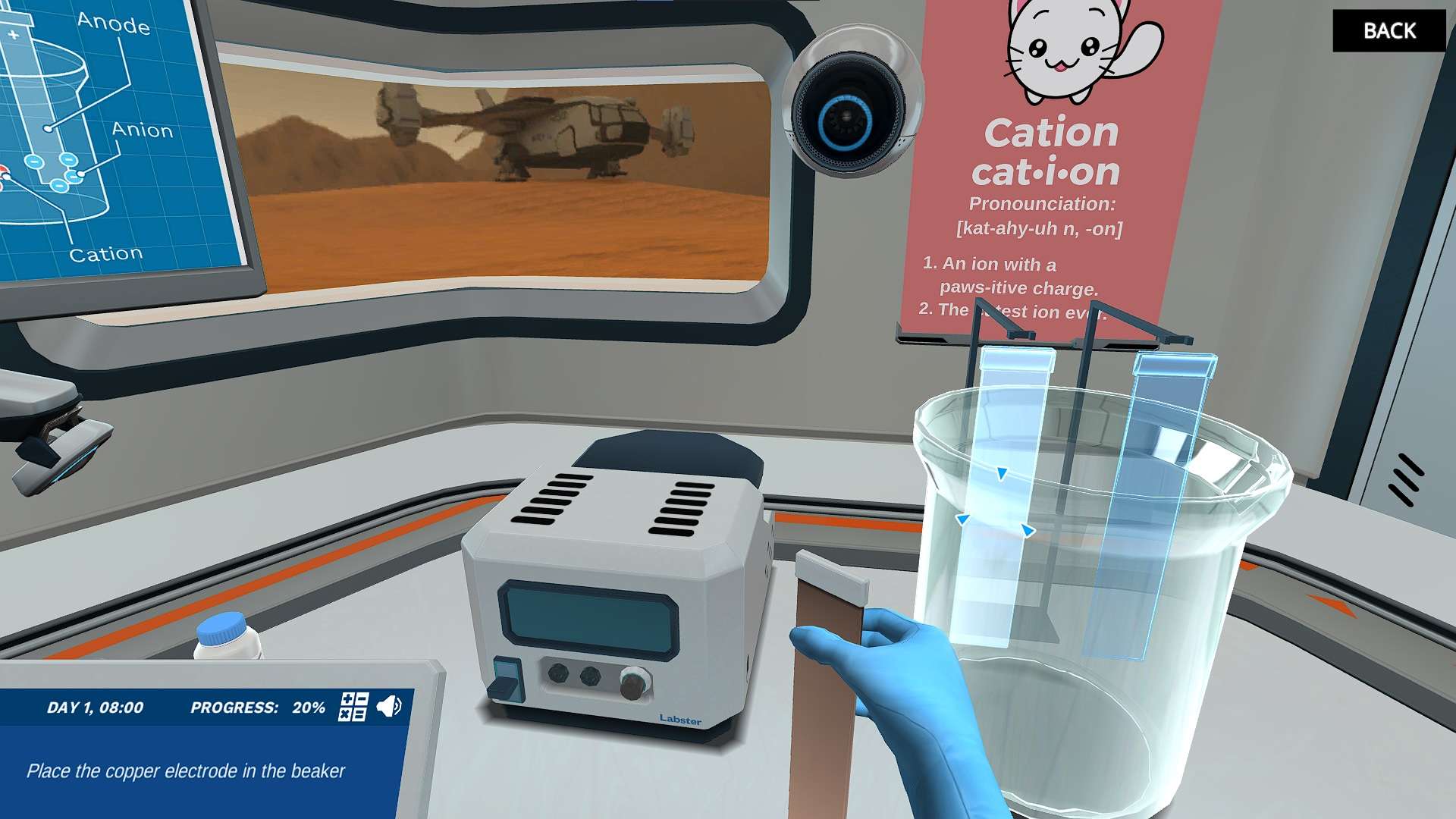Heading 1
Heading 2
Heading 3
Heading 4
Heading 5
Heading 6
Lorem ipsum dolor sit amet, consectetur adipiscing elit, sed do eiusmod tempor incididunt ut labore et dolore magna aliqua. Ut enim ad minim veniam, quis nostrud exercitation ullamco laboris nisi ut aliquip ex ea commodo consequat. Duis aute irure dolor in reprehenderit in voluptate velit esse cillum dolore eu fugiat nulla pariatur.
Block quote
Ordered list
- Item 1
- Item 2
- Item 3
Unordered list
- Item A
- Item B
- Item C
Bold text
Emphasis
Superscript
Subscript
About This Simulation
Experiment with electrolytic cells in a lab on Mars! Assemble different electrolytic cells so you can make hydrogen fuel for your Mars rover, and give mini Dr. One a new gold coating.
Learning Objectives
- Assemble electrolytic cell apparatus and describe the function of each component
- Identify the reactions occurring at the anode and cathode of electrolytic cells
- Describe the industrial utility of electrolytic techniques
About This Simulation
Lab Techniques
- Electrolysis
Related Standards
- HS-PS1-3
Learn More About This Simulation
Welcome to Mars! In this simulation, you will learn how to assemble an electrolytic cell and modify it for different applications. Start by building a simple electrolytic cell, and then learn about the reactions that take place during electrolysis. Apply your knowledge, to modify the electrolytic cell to make fuel for a Mars rover, and to give mini Dr. One a new gold coating.
Assemble an electrolytic cell
You have arrived on Mars and are excited to explore! But before you can set off, you find out your Mars rover needs fuel, and mini Dr. One needs a new metal coating. Luckily, this lab contains everything you need to assemble an electrolytic cell, including a handy schematic! The simple electrolytic cell you build can be modified for a variety of applications: including producing chemicals, and coating objects in metal
Discover how electrolysis works
In order for you to modify the electrolytic cell you built, you need to find out how electrolysis works. Dive into an interactive animation, where you will learn the function of the electrolytic cell components, and discover the chemical reactions that occur at each electrode. Return to the Mars lab, where you will test and apply your electrolysis knowledge.
Make hydrogen fuel for your Mars rover
Experiment with the components available to build two different electrolytic cells: one that makes hydrogen fuel, and another that can coat mini Dr. One in gold. Test your knowledge of each component by interacting with a schematic of an electrolytic cell. Can you get the rover, and mini Dr. One ready to explore Mars?
For Science Programs Providing a Learning Advantage
Boost STEM Pass Rates
Boost Learning with Fun
75% of students show high engagement and improved grades with Labster
Discover Simulations That Match Your Syllabus
Easily bolster your learning objectives with relevant, interactive content
Place Students in the Shoes of Real Scientists
Practice a lab procedure or visualize theory through narrative-driven scenarios


FAQs
Find answers to frequently asked questions.
Heading 1
Heading 2
Heading 3
Heading 4
Heading 5
Heading 6
Lorem ipsum dolor sit amet, consectetur adipiscing elit, sed do eiusmod tempor incididunt ut labore et dolore magna aliqua. Ut enim ad minim veniam, quis nostrud exercitation ullamco laboris nisi ut aliquip ex ea commodo consequat. Duis aute irure dolor in reprehenderit in voluptate velit esse cillum dolore eu fugiat nulla pariatur.
Block quote
Ordered list
- Item 1
- Item 2
- Item 3
Unordered list
- Item A
- Item B
- Item C
Bold text
Emphasis
Superscript
Subscript
A Labster virtual lab is an interactive, multimedia assignment that students access right from their computers. Many Labster virtual labs prepare students for success in college by introducing foundational knowledge using multimedia visualizations that make it easier to understand complex concepts. Other Labster virtual labs prepare learners for careers in STEM labs by giving them realistic practice on lab techniques and procedures.
Labster’s virtual lab simulations are created by scientists and designed to maximize engagement and interactivity. Unlike watching a video or reading a textbook, Labster virtual labs are interactive. To make progress, students must think critically and solve a real-world problem. We believe that learning by doing makes STEM stick.
Yes, Labster is compatible with all major LMS (Learning Management Systems) including Blackboard, Canvas, D2L, Moodle, and many others. Students can access Labster like any other assignment. If your institution does not choose an LMS integration, students will log into Labster’s Course Manager once they have an account created. Your institution will decide which is the best access method.
Labster is available for purchase by instructors, faculty, and administrators at education institutions. Purchasing our starter package, Labster Explorer, can be done using a credit card if you are located in the USA, Canada, or Mexico. If you are outside of North America or are choosing a higher plan, please speak with a Labster sales representative. Compare plans.
Labster supports a wide range of STEM courses at the high school, college, and university level across fields in biology, chemistry, physics, and health sciences. You can identify topics for your courses by searching our Content Catalog.















